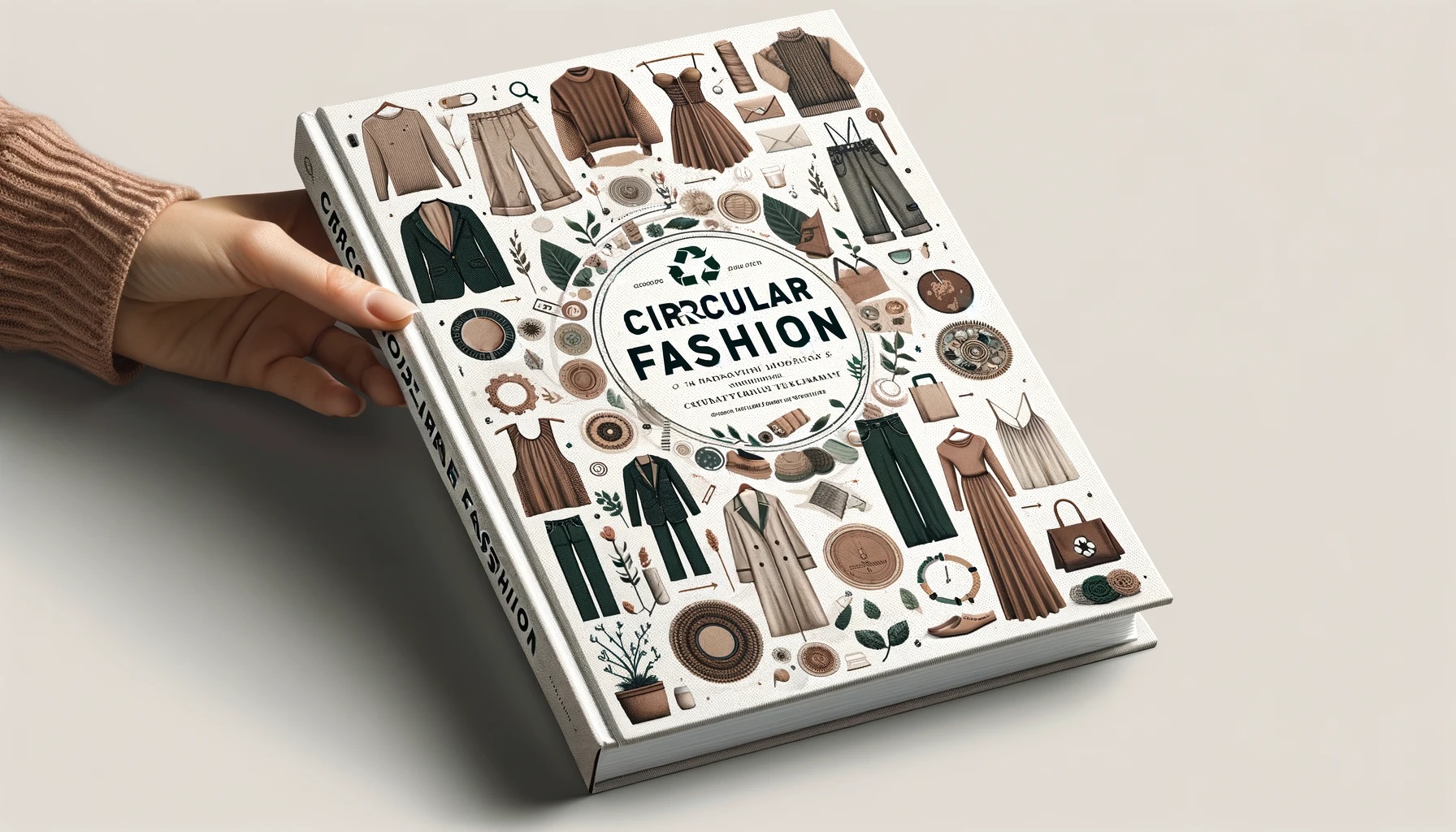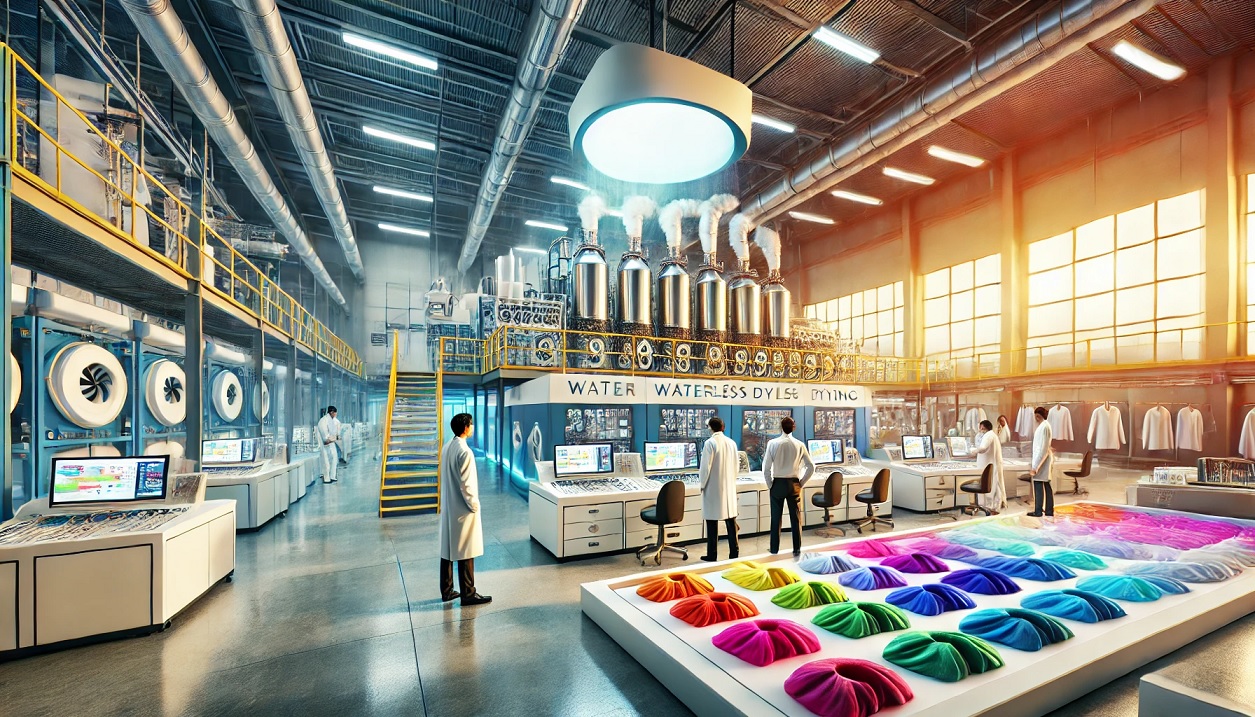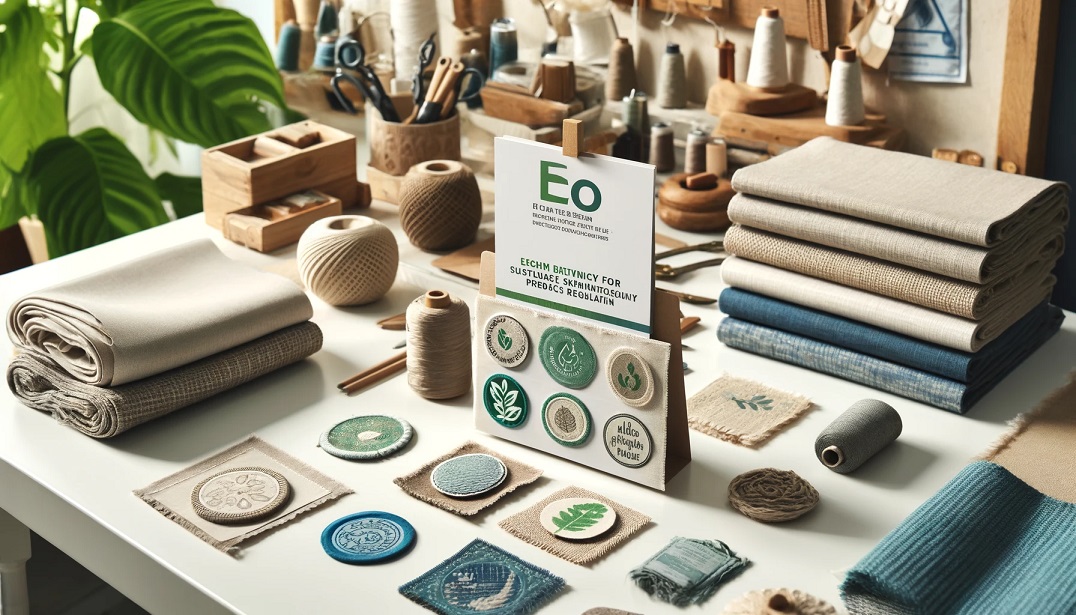Everything you need to know about circular textiles: (download link at the bottom of the page)
Chapter 1: Introduction to Circular Textiles
Definition and Concept
Circular Textiles refer to an approach in textile manufacturing and usage that aligns with the principles of the circular economy. This model stands in contrast to the traditional linear economy.
Linear Economy:
- The linear model follows a ‘take-make-use-dispose’ approach. Here, resources are extracted, transformed into products, used, and then discarded as waste. This model is prevalent in traditional textile production.
Circular Economy:
- In contrast, the circular economy emphasizes ‘reduce, reuse, recycle.’ It aims to keep resources in use for as long as possible, extract maximum value while in use, and then recover and regenerate products and materials at the end of their life.
In circular textiles, the goal is to design out waste and pollution, keep products and materials in use, and regenerate natural systems. It involves sustainable sourcing of materials, eco-friendly production processes, and the ability to recycle or compost the textiles after use.
Importance
Circular textiles offer significant environmental and economic benefits:
Environmental Benefits:
- Reduced Waste: By recycling and reusing textiles, the amount of waste sent to landfills is drastically reduced.
- Conservation of Resources: Circular practices decrease the demand for new resources, thereby conserving them.
- Lower Carbon Footprint: Sustainable production and recycling processes often consume less energy, contributing to a reduction in greenhouse gas emissions.
Economic Benefits:
- Cost Efficiency: Efficient resource use and waste reduction can lead to significant cost savings.
- New Business Opportunities: Circular models open up new avenues in recycling, upcycling, and sustainable fashion, creating economic growth and job opportunities.
- Resilience: A system less reliant on raw materials is more resilient to resource scarcity and market fluctuations.
Current Trend Highlight
The fashion and textile industry is increasingly embracing circular practices, responding to both environmental concerns and consumer demand:
- Sustainable Fashion: There’s a growing movement towards sustainable fashion, which includes using eco-friendly materials, ethical labor practices, and designing garments with longer lifespans.
- Zero-Waste Production: Many designers and brands are adopting zero-waste production methods, which aim to minimize or eliminate textile waste during the design and manufacturing process.
- Consumer Awareness: Consumers are becoming more environmentally conscious, driving demand for sustainable, ethically produced clothing.
The rise of circular textiles is part of a larger trend toward sustainability and environmental responsibility in the fashion industry. This chapter sets the stage for a deeper exploration of how circular principles are applied in textile production, use, and end-of-life management.
Chapter 2: Principles of Circular Textiles
Design for Longevity
Design for Longevity is a cornerstone principle in circular textiles. It involves creating textiles that are not only durable but also have a timeless appeal to ensure prolonged use.
Durability:
- Textiles are designed to withstand wear and tear, reducing the need for frequent replacements. This involves choosing high-quality fibers, robust construction techniques, and protective finishes that enhance the fabric’s lifespan.
Timeless Design:
- Fashion trends are transient, but circular textiles emphasize classic designs that remain stylish beyond seasonal trends. This approach encourages consumers to keep and use garments for longer periods.
Adaptability and Repairability:
- Designing for easy alterations, repairs, and upcycling is also a key aspect. This might involve simple design tweaks that allow for easy size adjustments or repairs.
Material Innovation
Material innovation in circular textiles focuses on developing sustainable materials that are either recyclable or biodegradable:
Recyclable Materials:
- These are fibers that can be recycled at the end of their lifecycle to create new textile products. This includes both natural fibers like cotton and wool, and synthetic fibers developed to be recyclable, like certain types of polyester.
Biodegradable Materials:
- Biodegradable textiles decompose naturally, returning to the earth without leaving harmful residues. Innovations in this area include new bio-based fibers derived from sources like algae, corn, and even waste products.
Blended Materials:
- Innovations also include developing blended materials that combine the benefits of natural and synthetic fibers while ensuring that the blend remains recyclable or biodegradable.
Resource Efficiency
Resource efficiency in circular textile production involves minimizing the use of natural resources, such as water and energy, and reducing waste generation:
Water Conservation:
- Techniques like rainwater harvesting, water recycling, and adopting water-efficient dyeing and finishing processes are employed to minimize water usage.
Energy Efficiency:
- Utilizing renewable energy sources, such as solar or wind power, in textile production. Also, optimizing manufacturing processes to reduce energy consumption.
Waste Reduction:
- Implementing zero-waste design principles where all material is used and nothing is wasted. Any waste generated is either reused in the production process or recycled.
In summary, the principles of circular textiles—design for longevity, material innovation, and resource efficiency—aim to create a more sustainable and environmentally friendly textile industry. By focusing on these principles, the industry can significantly reduce its ecological footprint while still meeting consumer needs. This chapter explores how each principle is integral to the transition towards a circular textile economy.
Chapter 3: Lifecycle of Circular Textiles
Production: Sustainable Practices
The production phase of circular textiles focuses on reducing environmental impact while creating high-quality products.
- Using Renewable Energy: Employing solar, wind, or other renewable energy sources in textile factories to minimize carbon emissions.
- Sustainable Sourcing: Choosing raw materials that are organic, recycled, or responsibly sourced to reduce environmental harm. This includes using certified organic cotton, recycled polyester, or sustainably harvested natural fibers.
- Water Management: Implementing water-saving techniques like rainwater harvesting and closed-loop water systems, especially in dyeing and finishing processes where water consumption is high.
- Waste Reduction: Adopting zero-waste design principles where fabric scraps are minimized and leftover materials are reused in production.
- Chemical Management: Utilizing non-toxic, eco-friendly dyes and finishing agents to protect the environment and workers’ health.
- Energy Efficiency: Incorporating energy-efficient machinery and processes to reduce the overall energy footprint of textile production.
Usage: Consumer Care Tips
Educating consumers on proper textile care can significantly extend the life of their garments.
- Washing Guidelines: Advising on cold water washes, gentle cycles, and using eco-friendly detergents to maintain fabric integrity and reduce energy consumption.
- Drying Practices: Encouraging air drying over machine drying to save energy and reduce fabric wear and tear.
- Mindful Usage: Recommending wearing clothes multiple times before washing, unless heavily soiled, to lessen water and energy use.
- Repair and Alterations: Encouraging mending torn or worn textiles and altering for fit or style changes, which can extend the life of a garment.
- Proper Storage: Instructing on correct storage methods like using breathable covers for storage and avoiding plastic bags to maintain fabric quality.
End-of-Life: Repurposing and Recycling
When textiles reach the end of their useful life, they can still contribute to the circular economy.
- Repurposing: Providing ideas for repurposing old textiles into new items like quilts, bags, or even art pieces.
- Recycling Programs: Informing about local or brand-specific textile recycling programs where old clothes can be turned into new fibers or products.
- Composting: For biodegradable textiles, explaining the process of composting at home or through community compost facilities.
- Donation: Encouraging the donation of wearable clothes to second-hand stores or charities.
- Chemical Recycling: Explaining advanced recycling processes where textiles are broken down to their chemical components and reformed into new fibers.
This chapter emphasizes the importance of each stage in the lifecycle of circular textiles, from mindful production practices to empowering consumers with knowledge on care and maintenance, and finally to responsibly managing the end-of-life of textiles. This holistic approach is crucial for transitioning towards a more sustainable and circular textile industry.
Chapter 4: Recycling and Upcycling in Textiles
Textile Recycling Processes
The recycling of textiles is a critical component in circular fashion, reducing waste and conserving resources. There are two primary methods of recycling textiles: mechanical and chemical.
Mechanical Recycling:
- This process involves physically breaking down fabrics into fibers. Textiles are shredded or pulled apart, and the resulting fibers are then cleaned and re-spun into new yarns. This method is most effective with single-material fabrics and is commonly used for cotton and wool. However, it often results in shorter fibers, which may be of lower quality than the original.
Chemical Recycling:
- In chemical recycling, textiles are broken down to their chemical constituents. This method is particularly useful for blended fabrics, as chemicals can selectively dissolve specific fiber types, allowing for their separation and extraction. The recovered materials can then be used to create new fibers of equal quality to virgin materials. This process is more complex and costly than mechanical recycling but offers a solution for recycling synthetic and blended fabrics that are otherwise difficult to recycle.
Upcycling Examples
Upcycling in textiles involves creatively repurposing old or discarded fabrics into new products, adding value through design and craftsmanship.
- Fashion Accessories: Old jeans or T-shirts can be transformed into bags, hats, or scarves. The unique aspects of the original materials, such as patterns or graphics, can be highlighted in the new product.
- Home Décor: Textile scraps can be repurposed into patchwork quilts, pillow covers, or curtains, offering a sustainable and personalized touch to home interiors.
- Artistic Projects: Textiles can be used in art installations or as materials for crafting, allowing for creative expression while reducing waste.
Challenges in Textile Recycling
Despite the benefits, textile recycling faces several challenges:
- Quality Degradation: Particularly in mechanical recycling, fiber length and strength can be reduced, impacting the quality of the recycled material.
- Material Complexity: Many garments are made from blended materials, making it difficult to separate and recycle the individual fibers.
- Economic Viability: The cost of recycling can be high, and the market for recycled fibers is still developing. This can make it financially challenging to sustain recycling operations.
- Lack of Infrastructure: There is a need for more widespread collection and sorting facilities specifically for textiles.
- Consumer Awareness and Participation: Educating consumers about recycling programs and encouraging participation is essential for the success of textile recycling.
Current Solutions
To address these challenges, various solutions are being explored:
- Technology Development: Advancements in chemical recycling technology are making it more efficient and cost-effective.
- Improved Sorting Techniques: Innovations in sorting technology, such as automated systems and AI, can better separate and categorize textiles for recycling.
- Building a Market for Recycled Textiles: Encouraging the fashion industry to use recycled materials and promoting consumer demand for products made from recycled textiles.
- Educational Initiatives: Raising awareness among consumers about the importance of textile recycling and how they can contribute.
This chapter sheds light on the vital role of recycling and upcycling in achieving circularity in the textile industry. While there are challenges, ongoing innovations and solutions offer promising paths to a more sustainable and waste-free textile future.
Chapter 5: Innovations in Circular Textiles
Technological Advancements
The textile industry is witnessing a surge in innovative technologies that enhance sustainability and circularity.
- Advanced Recycling Technologies: Innovations in both mechanical and chemical recycling are making the process more efficient and less resource-intensive. New chemical recycling methods are being developed to handle mixed-fiber textiles, enabling the recovery of high-quality fibers.
- Sustainable Fabric Production: Techniques like 3D knitting and digital printing are reducing waste in garment production. These methods allow for precise material usage, minimizing off-cuts and surplus fabric.
- Waterless Dyeing Technologies: Innovations in dyeing processes are significantly reducing water usage. Techniques like CO2 dyeing, where liquid carbon dioxide is used instead of water, are paving the way for a more sustainable industry.
- Energy-efficient Manufacturing: Implementation of low-energy processes and machinery to minimize the carbon footprint of textile production.
Bio-Fabrics
Bio-fabrics represent a revolutionary step in sustainable textiles, using renewable resources for fiber production.
- Algae-Based Fabrics: Algae is being used to create biodegradable and sustainable textile fibers. Algae-based fabrics have the potential to reduce reliance on petrochemicals and decrease greenhouse gas emissions.
- Mushroom and Fungi Fabrics: Innovations include using mycelium (mushroom roots) to create leather-like materials. These bio-fabrics are completely biodegradable and can be grown to the required shape and size, reducing waste.
- Lab-Grown Materials: Scientists are exploring lab-grown fibers that mimic natural ones without the environmental impact. These include spider silk proteins produced by engineered bacteria and yeast, offering strength and flexibility without the need for harmful chemicals or intensive land use.
Digital Integration
Digital tools are increasingly being integrated into the textile industry to enhance traceability and sustainability.
- Blockchain Technology: Blockchain is being utilized to create transparent supply chains. It allows consumers and brands to trace the journey of a product from raw material to finished good, ensuring ethical and sustainable practices at every stage.
- RFID Technology: Radio-frequency identification (RFID) tags embedded in garments can store information about the product’s material, origin, and recommended recycling path. This aids in efficient sorting for recycling and provides consumers with valuable product insights.
- Data Analytics and AI: Leveraging data analytics and AI for predictive analysis in production can optimize resource use and reduce waste. AI can also help in designing sustainable materials and predicting trends to avoid overproduction.
In this chapter, we explored the cutting-edge innovations that are shaping the future of the textile industry. These advancements are not only making circular textiles more feasible but are also setting new standards in sustainability and environmental responsibility.
Chapter 6: Circular Fashion Brands and Case Studies
Brand Highlights
This section profiles fashion brands that have successfully integrated circular textile principles into their business models, demonstrating innovation and commitment to sustainability.
- Patagonia: A pioneer in sustainable fashion, Patagonia uses recycled materials for its clothing and advocates for environmental causes. Their Worn Wear program encourages customers to repair and reuse garments, reducing waste and extending the life of their products.
- Eileen Fisher: Known for its simple and elegant designs, Eileen Fisher has a robust take-back and renewal program. The brand collects old garments from customers to recycle or upcycle them into new designs, demonstrating a commitment to reducing waste.
- Adidas x Parley for the Oceans: Adidas collaborates with Parley to create shoes and apparel from upcycled marine plastic waste. This initiative not only recycles waste but also raises awareness about ocean pollution.
- Stella McCartney: A luxury brand that has been a front-runner in using sustainable materials like organic cotton, recycled polyester, and bio-based fabrics. Stella McCartney is also known for its commitment to cruelty-free fashion, avoiding leather and fur.
Success Stories
These case studies showcase the impact and benefits of circular fashion initiatives.
- H&M’s Global Change Award: H&M Foundation’s innovation challenge supports startups working on sustainable fashion technologies. Winners have included innovations in textile recycling, bio-fabrics, and eco-friendly dyeing processes, showing the potential for scalable sustainable solutions in the fashion industry.
- Levi Strauss & Co. Water<Less® technology: Levi’s Water<Less® initiative has saved over 3 billion liters of water since 2011. By altering the finishing process, the brand significantly reduces the amount of water used in the production of jeans.
- The Renewal Workshop: This initiative partners with brands to recover and renew their unsold inventory or returned items. The Renewal Workshop repairs, cleans, and updates garments, which are then sold again, reducing waste and promoting a circular model in the fashion industry.
These brands and case studies illustrate how the principles of circular fashion can be successfully applied in the real world. They demonstrate that sustainability and business success can go hand in hand, offering valuable lessons for others in the industry. Through their efforts, these pioneers are helping to reshape the fashion industry into a more sustainable, circular model.
Chapter 7: Consumer Role in Circular Textiles
Buying Smart: Choosing Sustainable Textiles and Fashion
Consumers play a pivotal role in driving the demand for sustainable textiles. Here are some guidelines for making more eco-friendly choices:
- Look for Sustainable Certifications: Seek out certifications like GOTS (Global Organic Textile Standard), Fair Trade, or OEKO-TEX, which indicate sustainable and ethical production practices.
- Research Brands’ Sustainability Practices: Before purchasing, research a brand’s commitment to sustainability, including their use of sustainable materials, production processes, and labor practices.
- Quality Over Quantity: Invest in high-quality garments that last longer, rather than cheaper, lower-quality fast fashion items.
- Consider Material Composition: Opt for natural, organic, or recycled materials. Be cautious of blended materials, as they can be challenging to recycle.
- Support Circular Fashion Initiatives: Patronize brands that have take-back programs, recycling schemes, or sell upcycled and recycled products.
Care and Repair: Prolonging Textile Life
Proper care and repair of textiles can significantly extend their lifespan, reducing waste and resource consumption:
- Follow Care Instructions: Adhere to washing instructions on garment labels to maintain fabric integrity.
- Gentle Washing: Use cold water and eco-friendly detergents; avoid excessive washing.
- Air Drying: Whenever possible, air dry clothes instead of using a dryer to conserve energy and prevent fabric damage.
- Mending and Alterations: Learn basic sewing skills for mending tears or reattaching buttons. Consider local tailoring services for more complex alterations.
- Repurpose Old Clothing: Get creative with old or damaged garments. Transform them into cleaning rags, quilts, or even new fashion items.
Participating in the Circular Economy
Consumers can actively contribute to the circular economy through various practices:
- Recycling Old Clothes: Utilize textile recycling bins or programs offered by certain brands and municipalities.
- Donating: Give away clothes that are in good condition to second-hand stores or charitable organizations.
- Shopping Second-hand: Purchase from thrift stores, consignment shops, or online second-hand marketplaces.
- Upcycling Projects: Engage in DIY projects to upcycle old textiles into new products.
- Educate and Advocate: Spread awareness about sustainable fashion and circular principles among peers and on social media.
In this chapter, we emphasized the critical role consumers play in the circular textile ecosystem. By making informed purchasing decisions, caring for and repairing textiles, and actively participating in recycling and upcycling efforts, consumers can significantly contribute to a more sustainable and circular fashion industry.
Chapter 8: Future of Circular Textiles
Emerging Trends in Circular Textiles
The future of circular textiles is shaped by emerging trends that are likely to define the industry in the coming years:
- Advanced Recycling Technologies: Continuous improvements in textile recycling, both mechanical and chemical, are anticipated. Innovations may include more efficient processes for separating fiber blends and recovering high-quality materials from post-consumer waste.
- Growth of Bio-Fabrics: The development and mainstream adoption of bio-fabrics, such as those derived from algae, mushrooms, or lab-grown materials, are expected to accelerate. These materials provide sustainable alternatives to traditional textiles, reducing dependency on non-renewable resources.
- Digitalization and Data Analytics: Enhanced use of digital tools like AI, blockchain, and RFID technology for supply chain transparency, inventory management, and consumer engagement. This trend will likely increase efficiency, traceability, and the personalization of fashion items.
- Rise of Circular Business Models: Business models such as clothing rental, repair services, and second-hand marketplaces are expected to gain more prominence. These models extend the lifecycle of garments and reduce overall textile waste.
- Consumer Involvement: Growing consumer awareness and demand for sustainable products will drive brands to adopt more circular practices. The rise of ‘conscious consumerism’ will see more customers making purchasing decisions based on a product’s environmental impact.
Global Impact of a Shift to Circular Textiles
A shift towards circular textiles holds significant implications for both the environment and the global economy:
Environmental Impact:
- Reduced Waste and Pollution: Circular textiles aim to minimize waste generation and pollution, contributing to cleaner oceans and landscapes.
- Conservation of Resources: By recycling and reusing materials, the circular approach reduces the need for virgin resources, conserving water, energy, and raw materials.
- Biodiversity and Ecosystem Protection: Sustainable sourcing and production practices help in preserving natural habitats and biodiversity.
Economic Impact:
- New Economic Opportunities: Circular textiles can stimulate economic growth by creating new markets and job opportunities in areas like textile recycling, sustainable material production, and circular fashion retail.
- Cost Savings: Efficient resource use and waste reduction can lead to significant cost savings for businesses and consumers.
- Resilience and Sustainability: A circular economy is more resilient to resource shortages and environmental crises, ensuring a more sustainable future for the industry.
The future of circular textiles is not just about innovations and trends; it’s about a systemic shift in how we produce, use, and dispose of textiles. This shift promises a future where fashion and sustainability coexist, benefiting both the planet and its inhabitants. The potential global impact of this transition is immense, offering a pathway to a more sustainable and equitable world.
Chapter 9: Conclusion and Resources
Summary: The Importance of Circular Textiles in Sustainable Fashion
This guide has explored the transformative potential of circular textiles in the fashion industry. Circular textiles represent a paradigm shift from the traditional ‘take-make-dispose’ model to a more sustainable ‘reduce-reuse-recycle’ approach. This transition is critical for reducing environmental impacts such as waste, pollution, and resource depletion. By embracing circular principles, the textile industry can not only mitigate its ecological footprint but also pave the way for innovative and sustainable practices that could inspire other sectors.
Further Reading: Educational Resources
For those seeking to expand their knowledge on circular textiles and sustainable fashion, the following resources are invaluable:
Books:
- “Cradle to Cradle: Remaking the Way We Make Things” by William McDonough and Michael Braungart.
- “The Sustainable Fashion Handbook” by Sandy Black.
- “Fashionopolis: The Price of Fast Fashion and the Future of Clothes” by Dana Thomas.
Documentaries:
- “The True Cost” – A documentary exploring the impact of fashion on people and the planet.
- “RiverBlue: Can Fashion Save the Planet?” – An exploration of the environmental effects of the fashion industry on rivers.
Websites:
- The Ellen MacArthur Foundation (ellenmacarthurfoundation.org): A rich resource for information on the circular economy.
- Fashion Revolution (fashionrevolution.org): Advocates for a clean, safe, fair, transparent, and accountable fashion industry.
- Sustainable Fashion Forum (sustainablefashionforum.com): A platform discussing sustainable fashion.
Staying Informed: Keeping Up with Advancements
Staying current with the latest developments in circular textiles is crucial for both industry professionals and consumers:
- Subscribe to Industry Publications: Journals like “Journal of Cleaner Production” and “Sustainable Fashion and Textiles” offer insights into the latest research and developments.
- Follow Thought Leaders and Organizations on Social Media: Platforms like LinkedIn, Instagram, and Twitter are excellent for real-time updates and insights from sustainability experts and organizations.
- Attend Conferences and Webinars: Participating in industry events, either in-person or virtually, can provide valuable learning and networking opportunities.
- Engage with Online Communities: Join forums and discussion groups dedicated to sustainable fashion and textiles to share knowledge and stay informed about industry trends.
In conclusion, circular textiles are not just a trend but a necessity for a sustainable future in fashion. This guide, along with the recommended resources, aims to empower readers with the knowledge and tools needed to contribute to and benefit from the shift towards more sustainable and responsible textile practices. As the industry evolves, staying informed and engaged will be key to making the most of the opportunities that circular textiles present.



